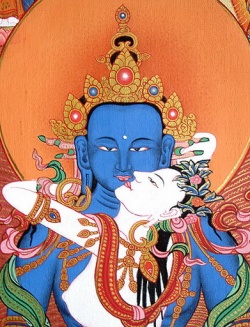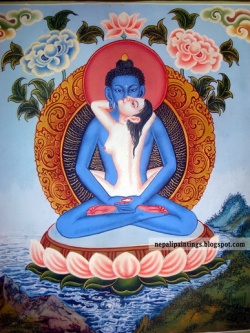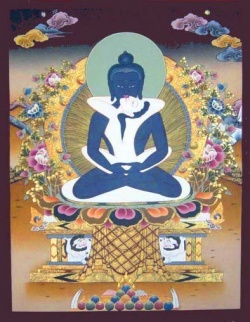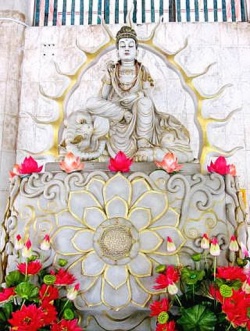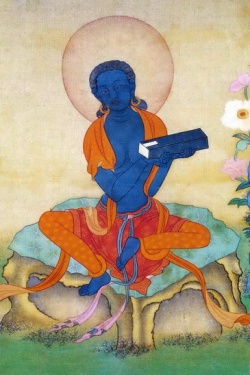Samantabhadra Bodhisattva (Phổ Hiền Bồ Tát)
Samantabhadra (Sanskrit; Devanagari: समन्तभद्र; lit. Universal Worthy), is a bodhisattva in Mahayana Buddhism associated with Buddhist practice and meditation. Together with Shakyamuni Buddha and fellow bodhisattva Manjusri he forms the Shakyamuni
trinity in Buddhism. He is the patron of the Lotus Sūtra and, according to the Avataṃsaka Sūtra, made the ten great vows which are the basis of a bodhisattva. In China, Samantabhadra is associated with action, whereas the bodhisattva Mañjuśrī is associated
with wisdom. In Japan this bodhisattva is often venerated by the Tendai and Shingon sects, and as the protector of the Lotus Sūtra by the Nichiren sect.
Samantabhadra is regarded as Adi-Buddha and as first Dhyani - Bodhisattva
Among the ancient Northern Buddhist sects and the unreformed Lamaist sects in Tibet, SAMANTABHADRA was looked upon as Highest Intelligence, a primordial Buddha, or Adi-Buddha. He is figured seated with the legs locked; but unlike the other representations
of Adi-Buddha, he has neither crown nor ornaments, and in his esoteric form was represented nude in blue color embracing his Sakti consort in white color.
An Adi-Buddha infinite, omniscient, self-existing, without beginning and without end, the source and originator of all things, who by virtue of five sorts of wisdom jnana and by the exercise of five meditations dhyana evolved five Dhyani Buddhas. When this Adi-Buddha is represented with his female energy, he is called Yogambara and the sakti Digambara Jnanesvari.
Certain Lamaist sects of later reformed Buddhism claim that Samantabhadra is the first Dhyani-Biddhisattva corresponding with five celestial Dhyani-Buddhas, and is one of the groups of eight Boddhisattava. As first Dhyani-Boddhisattva, he is represented with the crown, the
ornaments, and princely garment of Boddhisattva, and holds his symbol, the cintamani, in his left hand, or it may be supported by blue lotus at his left shoulder. The right hand makes vitarka mudra: the hand raised - the thumb and index touching at the tips forming the 'triangular pose'. He may be either seated or standing; and is sometimes with his sakti ?in the yab-yum ?attitude.
When in group of eight Boddhisattva, he is standing with his hands in 'argument' and 'charity' mudra, holding the stems of lotus-flowers which support his special symbol, the cintamani, at the right, and an accessory symbol, the vajra, at the left. If painted, he is yellow
In the Nyingma school of Tibetan Buddhist Vajrayana, Samantabhadra is considered a primordial Buddha in indivisible yab-yum union with his consort Samantabhadri.
Samantabhadra, pictured in Bodhisattva of Universal Virtue who Prolongs Life, 12th century painting on silk, late Heian period.
In the Lotus Sūtra, Samantabhadra is described at length in the epilogue, called the Samantabhadra Meditation Sutra (Chinese: 觀普賢菩薩行法經; pinyin: Guān Pǔxián Púsà Xíngfǎ Jīng), with special detail given to visualization of the bodhisattva, and the virtues of devotion to him.[1]
Samantabhadra is also a key figure in the Avataṃsaka Sūtra, particularly the last chapter, the Gandhavyuha Sutra. In the climax of the Gandhavyuha Sutra, the student Sudhana meets Samantabhadra Bodhisattva, who teaches him that wisdom only exists for the sake of putting it into practice; that it is only good insofar as it benefits all living beings.
In the Avataṃsaka Sūtra, the Buddha states that Samantabhadra Bodhisattva made ten great vows in his path to full Buddhahood:
To pay homage and respect to all Buddhas.
To praise all the Buddhas.
To make abundant offerings. (i.e. give generously)
To repent misdeeds and evil karmas.
To rejoice in others' merits and virtues.
To request the Buddhas to continue teaching.
To request the Buddhas to remain in the world.
To follow the teachings of the Buddhas at all times.
To accommodate and benefit all living beings.
To transfer all merits and virtues to benefit all beings.
The ten vows have become a common practice in East Asian Buddhism, particularly the tenth vow, with many Buddhists traditionally dedicating their merit and good works to all beings during Buddhist liturgies.
In Mahayana Buddhism
Unlike his more popular counterpart Manjusri, Samantabhadra is only rarely depicted alone and is usually found in a trinity on the right side of Shakyamuni, mounted on a white elephant. In those traditions that accept the Avatamsaka Sutra as its root instruction, Samantabhadra and Manjusri flank Vairocana Buddha, the central Buddha of this particular sutra.
Known as Pǔxián in Chinese, he is sometimes shown in Chinese art with feminine characteristics, riding an elephant with six pairs of tusks while carrying a lotus leaf 'parasol' (Sanskrit: chhatra), bearing similar dress and features to some feminine
depictions of Kuan Yin. It is in this guise that Samantabhadra is revered as the patron bodhisattva of the monasteries associated with Mount Emei in western China. Some believe that the white elephant mount of Samantabhadra was the same elephant that appeared to Queen Maya, the mother of the Buddha, to herald his birth.
Among those esoteric traditions that treat Samantabhadra as the 'Primordial' (Sanskrit: Dharmakaya) Buddha, he is often represented 'naked' ("sky clad"; Sanskrit: digambara), with a dark blue body, in union with his consort Samantabhadri.
In Esoteric Buddhism
In the Tibetan Buddhist tradition, particularly the Nyingma school, Samantabhadra is considered the most primordial Buddha, akin in status to Vajradhara for the Sarma traditions. Samantabhadra appears in the Vajrayana tantric text the [[Kunjed Gyalpo
Tantra]], as the Primordial Buddha, the 'embodiment' (Sanskrit: kaya) or 'field' (Sanskrit: kṣetra) of 'timeless awareness, gnosis' (Sanskrit: jñāna) awakened since before the very beginning. Therefore in Tibetan Buddhism the Nyingma, or 'Old Translation' school, the Sakya and the Bön schools view Samantabhadra as the Primordial Buddha. In the Nyingma school of Tibetan Buddhist
Vajrayana, Samantabhadra is considered a primordial Buddha in indivisible yab-yum union with his consort Samantabhadri. However, the Kagyu and Gelug schools use Vajradhara to represent the Primordial Buddha.
Dzongsar Khyentse Rinpoche following the Nyingmapa Dzogchen tradition qualifies the nature and essence of Samantabhadra, the Primordial Buddha, as the origin-less wellspring of the timeless and unbounded Atiyoga teachings, and honours the converse view entertained by some
interested parties which hold that the Dzogchen teachings originated with either the Bonpo tradition or the Chinese monk Moheyan (1990: p.xxi):
Samantabhadra is not subject to limits of time, place, or physical conditions. Samantabhadra is not a colored being with two eyes,
etc. Samantabhadra is the unity of awareness and emptiness, the unity of appearances and emptiness, the nature of mind, natural clarity with unceasing compassion - that is Samantabhadra from the very beginning.[2]
Samantabhadra is usually presented with colour black. The Dorje Zahorma hat, that is a special form of the Dorje Zahorma hat which is particular to Chatral Rinpoches tradition, is emblazoned with an image of Samantabhadra.[3]
'The Mirror of the Mind of Samantabhadra' (Tibetan: ཀུན་ཏུ་བཟང་པོ་ཐུགས་ཀྱི་མེ་ལོང; Wylie: kun tu bzang po thugs kyi me long) is one of the Seventeen Tantras of Dzogchen Upadesha.[4]
In Sri Lanka
Sri Lankan people venerates Samantabhadra Bodhisatva as Saman (also called Sumana, Samantha, Sumana Saman, Sinhalese: සුමන සමන් දෙවි). The name Saman means "the rising morning sun". God Saman is considered one of the guardian deities of the island and Buddhism. His main shrine is located in Ratnapura, where there is an annual festival held in his honor[5].
Notes:
CHAPTER TWENTY-EIGHT - THE ENCOURAGEMENT OF UNIVERSAL WORTHY BODHISATTVA Translated by The Buddhist Text Translation Society in USA
Khyentse, Dzongsar (1990). "Introduction: The Significance of This Biography" in: Palmo, Ani Jima (Eugenie de Jong; translator); Nyingpo, Yudra (compilor, et al.) (2004). The Great Image: the Life Story of Vairochana the translator. Shambala Publications, Inc.: Boston, Massachusetts, U.S.A. ISBN 1-59030-069-6 (pbk.: alk. paper). p.xxi
Photograph with explanatory text
^ Rigpa Shedra (October, 2009). Seventeen Tantras. Source: [1] (accessed: Monday April 5, 2010)
^ "The Gods & Deity Worship in Sri Lanka". Retrieved 2010-06-28.
References and Further Reading
Yeshe De Project (1986). Ancient Tibet: Research materials from the Yeshe De Project. California: Dharma Publishing. ISBN 0898001463.
Dudjom Rinpoche; Jikdrel Yeshe Dorje (1991). The Nyingma School of Tibetan Buddhism: its Fundamentals and History. Two Volumes. Boston: Wisdom Publications. ISBN 0861710878.
